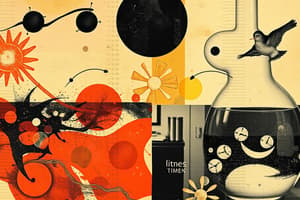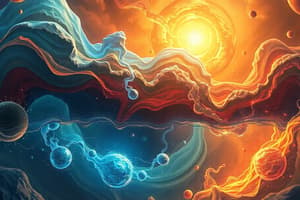Podcast
Questions and Answers
What is a physical change?
What is a physical change?
What happens during a chemical change?
What happens during a chemical change?
The chemical composition of the substance may change.
Which of the following is an example of a physical change?
Which of the following is an example of a physical change?
It is possible to have a color change without a chemical change.
It is possible to have a color change without a chemical change.
Signup and view all the answers
What is sublimation?
What is sublimation?
Signup and view all the answers
What occurs when two solutions are combined?
What occurs when two solutions are combined?
Signup and view all the answers
Which process does not change the composition of a substance?
Which process does not change the composition of a substance?
Signup and view all the answers
When solid or liquid substances are combined, they may form _____ bubbles.
When solid or liquid substances are combined, they may form _____ bubbles.
Signup and view all the answers
What indicates that a chemical reaction has taken place?
What indicates that a chemical reaction has taken place?
Signup and view all the answers
Study Notes
Physical Change
- Involves a change in the state of matter without altering the substance's composition.
- Examples include melting ice cream, hardening wax, and evaporating water.
- Changes in size or shape, such as cutting, tearing, or dissolving, do not change the substance's chemical identity.
- Sublimation, such as dry ice turning into gas or frost forming from vapor, is still a physical change.
Chemical Change
- Involves a change in the substance’s chemical composition, often accompanied by a color change.
- Examples include rusting iron, browning apples, and blackened marshmallows from burning.
- A color change can occur without a chemical change, for instance, adding food coloring to water.
- Combustion results in temperature change, such as wood burning to ash and gases.
Key Observations
- Combining substances can lead to temperature changes and the formation of new products.
- A precipitate forms when two solutions react, indicating a chemical change occurred.
- Gas production, like bubbles forming when vinegar reacts with baking soda, signals a chemical reaction.
- Precipitates can appear as cloudiness or settle as solid particles in a solution.
Studying That Suits You
Use AI to generate personalized quizzes and flashcards to suit your learning preferences.
Description
Test your understanding of physical and chemical changes in matter. This quiz explores the differences between these changes through various examples and key observations. Discover how temperature changes and color variations signify these transformations.




